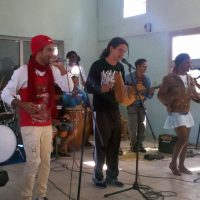Harbinger of Spring in Seattle – Early flowering cherries on Azalea Way!
Most visitors experiencing the beauty of our historic Azalea Way flowering cherries from now through May probably have no idea of how intensive maintaining their health and prolonging their longevity truly is for the UW Botanic Gardens horticulture staff.
Read moreThe Red Maples are flowering
The Red or Swamp Maple, Acer rubrum, is always noticed for its intense flame color in the fall, but I love these trees best right now – when they are covered in flowers prior to foliation.
From a distance the light gray bark of the tree sets off the pink & maroon flowers creating a stunning effect – it’s as if the tree is full of red fuzz.
March Color Appears at the Washington Park Arboretum (Part II)
Pacific Connections Garden
1) Corokia x virgata ‘Sunsplash’
An odd shrub from New Zealand with variegated foliage and wiry, twisty branches.
This carefree evergreen tolerates some dry and looks great in containers.
Specimens can be found in the New Zealand Entry Garden.
2) Grevillea victoriae
Fine-textured foliage, long thin flower clusters and drought tolerance make these evergreen shrubs very popular.
Also known as Royal Grevillea, it is endemic to parts of Victoria in Australia.
Fiddleheads Forest School: A Nature Preschool at the UW Botanic Gardens
In September, the UW Botanic Gardens will open an outdoor, nature-based preschool. The Fiddlehead Forest School is a play-based, exploratory and outdoor program that creates opportunities for children to develop meaningful and caring relationships with one another and the natural world.
GRAND OPENING SEPTEMBER 2013
Fiddleheads Forest School: A Nature Preschool at the UW Botanic Gardens
Take a moment to envision a three year old.
Cuba, Una Vez Más

UWBG Director, Sarah Reichard, recounts her recent study tour to Cuba, a beautiful, musical and confounding country.
Read moreWhat’s Going on Around the Burnt Tree?
If you have walked around Shoveler’s Pond in the Union Bau Natural Area this month you have seen the area undergoing a flurry of activity from plowing to bulldozers moving dirt.
Read moreBuilding the New Zealand Forest, Pacific Connections Update
The 2.5 acre New Zealand focal forest construction project is scheduled to be completed by the end of June. Planting will begin in June. There will be approximately 10,000 total plants representing over 90 taxa for the 9 plant communities that will be represented.
Read moreMarch Color Appears at the Washington Park Arboretum
1) Camellia japonica ‘High Hat’
One of our earlier-flowering Japanese camellias.
This specimen can be found along the west side of Arboretum Drive near the construction zone detour.
2) Pieris japonica ‘Valentine’s Day’
Showing its large panicles of pink flowers.
Can be found on Azalea Way just south of the Lilacs.
3) Rhododendron floribundum
Native to the Szechwan Province of China.
Read moreUW Student Restoration Ecology Program featured in BGjournal
The January 2013 edition of BGjournal features an article on the restoration work UW students have accomplished as part of the Restoration Ecology Capstone course sequence. The capstone works with community partners to accomplish restoration projects in and around Seattle. Capstone projects have helped to restore 15 acres of the Union Bay Natural Area, a former landfill.
To learn more, read the full article:
BGjournal 10.1
Amphibian Monitoring at the Arboretum
The Woodland Park Zoo, in collaboration with several other local organizations, is working with volunteers to survey amphibian egg masses in local ponds and wetlands, including the Arboretum. Volunteers began 2013 monitoring in February. Already they have discovered loads of live Tree Frog eggs and possible Northern Red-legged Frog eggs in the upper pond of the Woodland Garden area! To read more about the program, scroll down to the “Amphibian Monitoring 2013” story on this page.
Read more